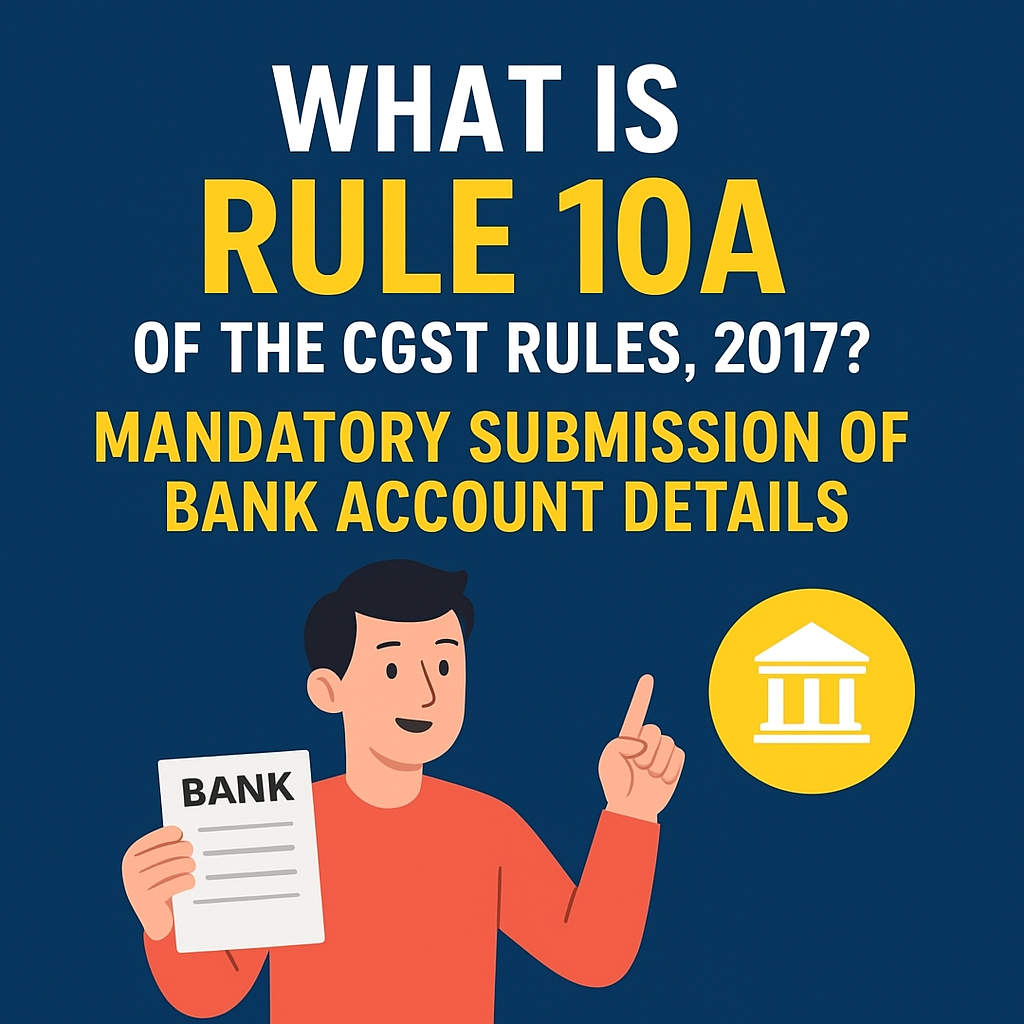GSTN set to suspend GSTIN over this compliance violation
GSTN, on 20 November 2025, issued a new advisory emphasizing that taxpayers must furnish their bank account details in accordance with Rule 10A of the CGST Rules, 2017. This obligation covers all registered persons, excluding TCS/TDS applicants and individuals who were granted GST registration through suo-moto action by the department.
What Does Rule 10A of the CGST Rules Mean?
Rule 10A requires that every GST-registered taxpayer—except a few specified categories—must provide their bank account details within 30 days of obtaining GST registration or before filing their first outward supply return (GSTR-1 or IFF), whichever occurs earlier.
Latest Update Issued on 20 November 2025
GSTN has announced that strict enforcement of Rule 10A will soon be activated on the GST portal.
Important points from the advisory:
✔ Mandatory Submission Timeline
Bank account details must be furnished:
-
Within 30 days of receiving GST registration,
OR -
Before filing GSTR-1 or IFF,
whichever condition is met first.
✔ Who Needs to Follow This Requirement?
All GST-registered persons except the following:
-
TDS deductors (under Section 51)
-
TCS collectors (under Section 52)
-
Taxpayers who received GSTIN through suo-moto registration (Section 62)
✔ What Happens If You Don’t Update Your Bank Details?
Failure to comply may result in suspension of the GST registration on the portal.
Possible consequences include:
-
Inability to file GST returns
-
Blocking of e-way bill generation
-
Restriction on making outward supplies
-
Risk of cancellation proceedings
Taxpayers are strongly encouraged to update their bank details promptly to prevent any operational or compliance-related disruptions.
Why Has GSTN Issued This Advisory at This Stage?
GSTN has released this clarification due to a growing number of instances where:
-
GST registrations are obtained without any real business operations
-
GSTINs are created without linking a valid bank account
-
Fake invoices are generated even before verification is completed
-
Refunds are claimed without proper banking trails or genuine transactions
By tightening compliance under Rule 10A, GSTN aims to:
✔ Detect fake invoicing networks at an early stage
✔ Prevent fraudulent or non-genuine registrations
✔ Reduce refund frauds and misuse of input tax credit (ITC)
✔ Strengthen taxpayer verification and system reliability
This measure aligns with the Government’s ongoing efforts to enhance the transparency and credibility of the GST framework.
Penalties and Consequences for Not Complying with Rule 10A
If a taxpayer does not update their bank account details within the prescribed timeline, the following actions may occur:
1️⃣ GST Registration May Be Suspended
Your GSTIN will shift to a “Suspended” status, immediately affecting business operations.
2️⃣ GSTR-1 Filing Will Be Blocked
You won’t be able to report outward supplies, which affects your customers and hampers regular business activity.
3️⃣ E-Way Bill Services Will Be Disabled
Movement of goods gets restricted because the portal blocks e-way bill generation.
4️⃣ Department May Issue Notices
The GST department may initiate cancellation proceedings under Rule 21.
5️⃣ Customers’ ITC May Get Affected
If your registration is suspended, the ITC of your buyers may be blocked, leading to disputes and compliance issues.
How to Update Bank Account Details on the GST Portal (Step-by-Step)
Bank details must be updated through a Non-Core Amendment on the GST Portal.
Step 1: Log In
Visit gst.gov.in and sign in using your credentials.
Step 2: Open the Registration Section
Go to:
Services → Registration → Amendment of Registration (Non-Core Fields)
Step 3: Choose the ‘Bank Accounts’ Tab
Enter the following information:
-
Account holder’s name
-
Account number
-
IFSC code
-
Bank name
-
Supporting proof (cancelled cheque/passbook/bank statement)
Step 4: Upload Proof
Make sure the uploaded document clearly shows:
-
Account number
-
Name of the account holder
-
IFSC code
-
Bank name
Step 5: Verify & Submit
Submit the amendment using DSC or EVC.
An ARN will be generated after submission.
If the details match PAN records and GST data, approval is usually automatic.
Which Documents Are Accepted as Valid Proof?
The GST Portal permits the following documents as proof of bank account details:
-
A cancelled cheque
-
The first page of the bank statement
-
The first page of the passbook
The document must clearly display the account holder’s name, account number, IFSC code, and bank name.
Common FAQs for Taxpayers and Professionals
1️⃣ Can a savings account be used?
Yes. Proprietors may use a savings account, although opening a current account is preferable for business transactions.
2️⃣ Is a joint bank account allowed?
No. The bank account must be solely in the name of the person or entity holding the GST registration.
3️⃣ What if the bank account has not been opened yet?
Open the account and update the information at the earliest. Delays may result in registration suspension.
4️⃣ Can a taxpayer begin business without updating bank details?
No. GSTR-1 filing is blocked until bank account details are added.
5️⃣ What if incorrect bank details were submitted?
You must revise the information through a Non-Core Amendment. Incorrect details can also trigger suspension.
The GSTN advisory issued on 20 November 2025 clearly indicates that providing bank account information under Rule 10A is no longer optional—it is a mandatory compliance requirement directly tied to maintaining an active GST registration.
Taxpayers and practitioners should ensure the details are updated promptly to avoid disruptions.

